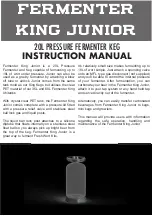
13
8. The unit delivers heat to the conditioned space until the
thermostat is satisfied; integrated control module monitors
safety circuits continuously.
9. R and W thermostat contacts open, completing the call for
heat; gas valve de-energizes.
10. Induced draft blower keeps operating for 30-second post
purge.
11. Ignition control begins timing the HEAT FAN OFF
delay. There is an adjustable HEAT FAN OFF delay of
approximately 90/120/150/180 seconds (factory set at 150).
NOTE:
This delay allows any additional heat in the heat
exchanger to be transferred to the conditioned space. After the
HEAT FAN OFF delay time has elapsed, the blower will de-
energize.
Cooling
1. Thermostat calls for low or high stage cooling.
2. If the thermostat call is for low stage cooling, the compressor
and outdoor fan are energized at low stage. If the thermostat
call is for high stage cooling, the compressor and outdoor
fan are energized at high stage.
3. The indoor blower will energize approximately 6 seconds
later.
4. The unit delivers cooling to the conditioned space until the
thermostat is satisfied.
5. The compressor and outdoor fan will be de-energized when
the thermostat opens.
6. The indoor blower continues to run at low cool speed for
approximately 60 seconds after the thermostat is satisfied.
This allows additional cooling from the indoor coil to be
transferred to the conditioned space. Then, the indoor
blower is de-energized.
NOTE: A 180-second anti-short cycle is integral to the control and
prevents recycling of the compressor.
Fan Only
1. Thermostat calls for FAN ONLY by energizing “G”.
2. Indoor blower is energized at fan only speed. DP16U
models are equipped with ECM variable speed motor; the
fan only blower speed is approximately 75% of the HIGH
COOL speed for DP16U models.
3. The indoor blower is immediately de-energized once
thermostat call for FAN is removed.
Startup, Adjustments, and Checks
Heating Startup
This unit is equipped with an electronic ignition device to
automatically light the main burners. It also has a power vent
blower to exhaust combustion products.
On new installations, or if a major component has been replaced,
the operation of the unit must be checked.
Check unit operation as outlined in the following instructions. If
any sparking, odors, or unusual sounds are encountered, shut
off electrical power and check for wiring errors, or obstructions in
or near the blower motors. Duct covers must be removed before
operating unit.
Burner Limit Control
The burner temperature switch is mounted on the burner
assembly to monitor the burner box temperature. It is normally
closed (electrically), auto-reset sensor. An input to the control is
provided by the normally closed blocked burner switch. An open
blocked burner switch interrupts current to the gas valve which
closes the valve. This switch guards against the burner flames not
being properly drawn into the heat exchanger.
Secondary Limit Control
The secondary limit control is located on the top of the blower
scroll assembly. This control opens when elevated temperatures
are sensed. Elevated temperatures at the control are normally
caused by blower failure. The reason for the opening should be
determined and repaired prior to resetting.
If the power to the unit is interrupted during the heating cycle,
it may cause the secondary limit to trip. Once the blower
compartment temperature drops below the limit reset temperature,
the limit will automatically reset.
Secondary
Control Limit
Back of Unit
Secondary Limit Control
Pre-Operation Checks
1. Close the manual gas valve external to the unit.
2.
Turn off the electrical power supply to the unit.
3. Set the room thermostat to its lowest possible setting.
4. Remove the heat exchanger door on the side of the unit by
removing screws.
5. This unit is equipped with an ignition device which
automatically lights the main burner. DO NOT try to light
burner by any other method.
6. Move the gas control valve switch to the OFF position. Do
not force.
7.
Wait five minutes to clear out any gas.
Summary of Contents for DP14U Series
Page 23: ...23 APPENDIX Unit Dimensions...














































